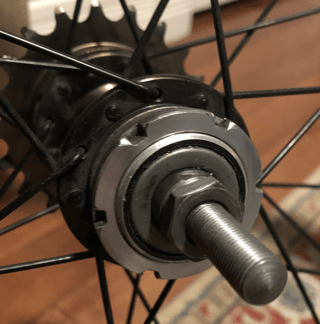After having my bike worked on recently at the LBS I noticed that my rear axle lock nuts are arranged so that the smooth/flat sides are contacting the dropouts. To clarify, I'm discussing the lock nuts that go outside the cones, not the axle/track nuts that secure everything to the frame.
I removed the wheel and loosened the lock nuts for the sake of some photos.
From observing photos of other people's axles, it seems like the rough/beveled/textured/grooved/serrated edge should face away from the center/wheel and towards the outside/frame. The opposite of how mine are installed.
As far as I can tell from my research, this is the common orientation. Rough side faces out, smooth side faces in.
<rough|smooth] [smooth|rough>
[etc] [frame] [lock nut] [etc. hub stuff] [lock nut] [frame] [etc]
The photos I've found all seem to imply the rough side touching the dropouts is the right way to do it, but I can't find any conclusive results for bike axle nut which way or bike axle nut which direction.
Is that a general rule for axle lock nuts that the rough side should always face the dropouts?


